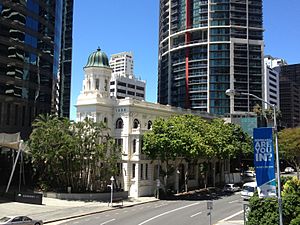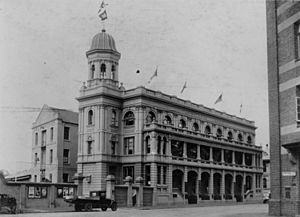Naldham House facts for kids
Quick facts for kids Naldham House |
|
|---|---|

Naldham House, 2013
|
|
| Location | 193 Mary Street, Brisbane City, City of Brisbane, Queensland, Australia |
| Design period | 1840s - 1860s (mid-19th century) |
| Built | 1864 - 1889 |
| Architectural style(s) | Classicism |
| Official name: Naldham House, AUSN House | |
| Type | state heritage (built) |
| Designated | 21 October 1992 |
| Reference no. | 600133 |
| Significant period | 1864-1889 (fabric) 1864-1886 (historical) |
| Significant components | tower |
| Lua error in Module:Location_map at line 420: attempt to index field 'wikibase' (a nil value). | |
Naldham House is a historic office building in Brisbane, Queensland, Australia. It stands at 193 Mary Street in the city center. This building was constructed between 1864 and 1889. It is also known as AUSN House. Naldham House is recognized for its importance and was added to the Queensland Heritage Register on 21 October 1992.
A Look Back: Naldham House's Story
Naldham House has a long and interesting history. It was first built in 1864. Later, it was made bigger in the late 1870s. The building was then largely rebuilt in 1889. This was done for the Australian United Steam Navigation Company. For almost 100 years, it served as an office for shipping companies.
In 1988, the building changed a lot. It was updated inside and out. This was to turn it into a club. The land where Naldham House stands is next to the Brisbane River. The Australasian Steam Navigation Company (ASN) bought this land in 1852. They built their first wharves (docks) there in 1859.
In 1864, a two-story office building was put up. Henry O'Reilly, the ASN's agent in Brisbane, worked there. This first building was on the northern side of where Naldham House is today. In 1877, the ASN office in Brisbane became a main branch. The office building was made longer between 1875 and 1878. It reached the Felix Street corner.
In the mid-1880s, the ASN company joined with other shipping companies. They formed the Australasian United Steam Navigation Company (AUSN). This new company became very important in shipping across Queensland and Australia.
In 1888, architects McCredie Bros & Chambers asked for bids to expand the AUSN offices. J R Locke won the bid. The top floor was taken down, and two new floors were added. A tower and a small dome (cupola) were built on the northern end. A balcony was added to the Mary Street side. New entrances were also created.
In 1914, MacDonald Hamilton & Co became agents for AUSN. They updated the inside of the building around 1915-1920. This included adding silky oak wood panels on the first floor. They also changed the building's name to Naldham House. This name came from the middle letters of their company name. MacDonald Hamilton & Co managed AUSN until 1960. They made more changes inside the building. A new entrance to Mary Street was also built. The company stayed in the building until 1986.
In 1988-1989, big changes were made again. The building became part of a new riverside project called Waterfront Place. An old storage building next door was taken down. The eastern wall, which used to be plain, was made to look like the Mary Street side. This eastern wall is now the main entrance.
In 1994, the Brisbane Polo Club bought Naldham House. They used it as a private club and a place for meetings. In 2015, the club decided to close. A developer from Singapore bought the building. In 2016, Dexus Property Group bought Naldham House. They saw it as an important part of the Waterfront Place area.
What Does Naldham House Look Like?
Naldham House is on the corner of Mary and Felix Streets. It is a three-story building made of brick, covered in a smooth finish. It also has a basement. The building is long and narrow. The tower is at the end closest to the river. The new buildings around it mean you can't see the river from Naldham House anymore.
The main front of the building faces Mary Street. It has a colonnade (a row of columns) on the ground and first floors. The details on the front of the building mix different classical styles. Each level has different types of columns or decorations.
On the first floor, there are pairs of pilasters. These are flat, decorative columns attached to the wall. The colonnade on this floor has pairs of columns with special tops called Ionic capitals. The windows on the second floor are large and have rounded tops. Between these windows are more paired pilasters. These have one large Corinthian capital that goes across both of them. Above these capitals is a plain band (frieze) and a decorative ledge (cornice). Above that is a low wall (parapet) with small, decorative posts (balusters). The narrow northern side of the building has the date "1888" written on it.
The most special part of the building is its eight-sided tower. This tower has a small dome (cupola) on top. The cupola, the tower, and the street-facing sides of the building still look like they did when they were built.
The eastern side of the building now has the main entrance. It also has classical details. The date "1988" is written below the cornice. The inside of the building has been updated. The new staircase and interior were designed to look like a fancy club from the late 1800s.
Why Naldham House is Special
Naldham House is listed on the Queensland Heritage Register. This means it is an important historical place. It was added to the list on 21 October 1992.
Naldham House is important for a few reasons:
- It shows how Queensland's history developed. The building shows how important shipping was along the Brisbane River. It also highlights the big role the Australian United Steam Navigation Company played in Queensland's shipping history.
- It is a great example of a certain type of building. Naldham House is a wonderful example of a shipping company building from the late 1800s. It has a grand and impressive design.
- It has special beauty and design. The building is a beautiful example of a late 19th-century shipping office. It has a strong and impressive look. Naldham House is also important because it is one of the few grand old business buildings left from that time.


